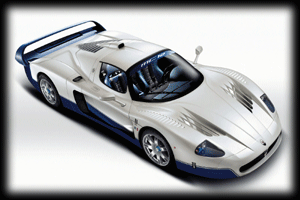After almost 40 years without success in international competencies, Maserati developed a prototype called MC12 for GT racing and plans to produce 50 for street.
 Giugiaro's idea was that Maserati technicians develop styling in the wind tunnel, with the fundamental contribution of Frank Stephenson, director of concept designs and developments of the Ferrari Maserati group.
Giugiaro's idea was that Maserati technicians develop styling in the wind tunnel, with the fundamental contribution of Frank Stephenson, director of concept designs and developments of the Ferrari Maserati group.
The street version, built for demanding sports handling, reaches 330 km/h and will begin production in 2004. It will be available only in white and blue colors combined (see photo), colors of the America Camoradi team that ran the famous Maserati Type 60 in the 60s with Stirling Moss at the wheel.
While the car was presented at the Genoa Motor Show in 2004, the Maserati competition division, under the command of engineer Giorgio Ascanelli, is developing the race model to comply with the regulations of the most important international categories.
The Maserati MC12 is a bi-plaza coupe spider long tail and great wheelbase. It has the typical look of a racing car and removable hard roof. It has a 630 hp central V12 engine. Its 1300 kilos, very reasonable weight because it is a sports car more than 5 meters long, are achieved thanks to the use of carbon fiber compounds in the body, “sandwich” of nomex and carbon in the chassis and two support structures type aluminum subchassis.
Generally speaking, it can be said that in this car the form follows function, despite being deeply rooted in technically inefficient design concepts, mainly in aerodynamics, where symptoms are attacked rather than disease. Surely this contrasts sharply with other opinions of designers who always have speeches at hand, such as: “the intensive evaluation in the wind tunnel and the mathematical calculations added to the driving tests make it clear that the form created is very efficient and pure, with great personality...” and blah blah blah...
In the technical aspect we can mention that it has two options or modes of operation: one sport and one race. The sport has traction control and the second allows the car to react as a real racing car would. The gearbox is semi-automatic, just like an F1 does not require a clutch, but the pilot drives a flap located behind the steering wheel and the gearbox selects the right time (by synchronism) to change the gear.
Inside there is a central console with the controls of the climate control system, a characteristic Maserati oval clock and the engine ignition button. The instrument is radially distributed around a speedometer just in front of the pilot. The doors have carbon fiber panels, slide pockets and buttons for electric windows. The pedals are made of aluminium.
Ratio of 105 hp / liter and 0.47 hp / kg
Power: 630 hp @ 7500 rpm
© Adrián Blanco 2004 — Prohibited the total or partial reproduction of text and/or images without explicit written consent of the author. —